Lesson 18
Using Long Division
18.1: Using Base-Ten Diagrams to Calculate Quotients (5 minutes)
Warm-up
Prior to grade 6, students have solved division problems using their understanding of place value and the idea of creating equal-size groups. This warm-up relies on those concepts to prepare students for more-abstract work in later lessons. The divisor and dividend are chosen so that the hundreds in the dividend can be partitioned into equal groups but the tens cannot. The quotient, however, is a whole number. The key ideas that would enable students to ultimately divide a decimal by a decimal are present in this example:
- A number can be decomposed to make the division convenient, e.g., 372 can be viewed as 300 + 60 + 12.
- Place value, expressed in the form of base-ten diagrams, plays a very important role in division.
Launch
Arrange students in groups of 2. Display Elena’s method for all to see and use as a reference. Give students 1 minute of quiet think time and 2 minutes to discuss with a partner. Follow with a whole-class discussion.
Student Facing
Elena used base-ten diagrams to find \(372 \div 3\). She started by representing 372.

She made 3 groups, each with 1 hundred. Then, she put the tens and ones in each of the 3 groups. Here is her diagram for \(372 \div 3\).
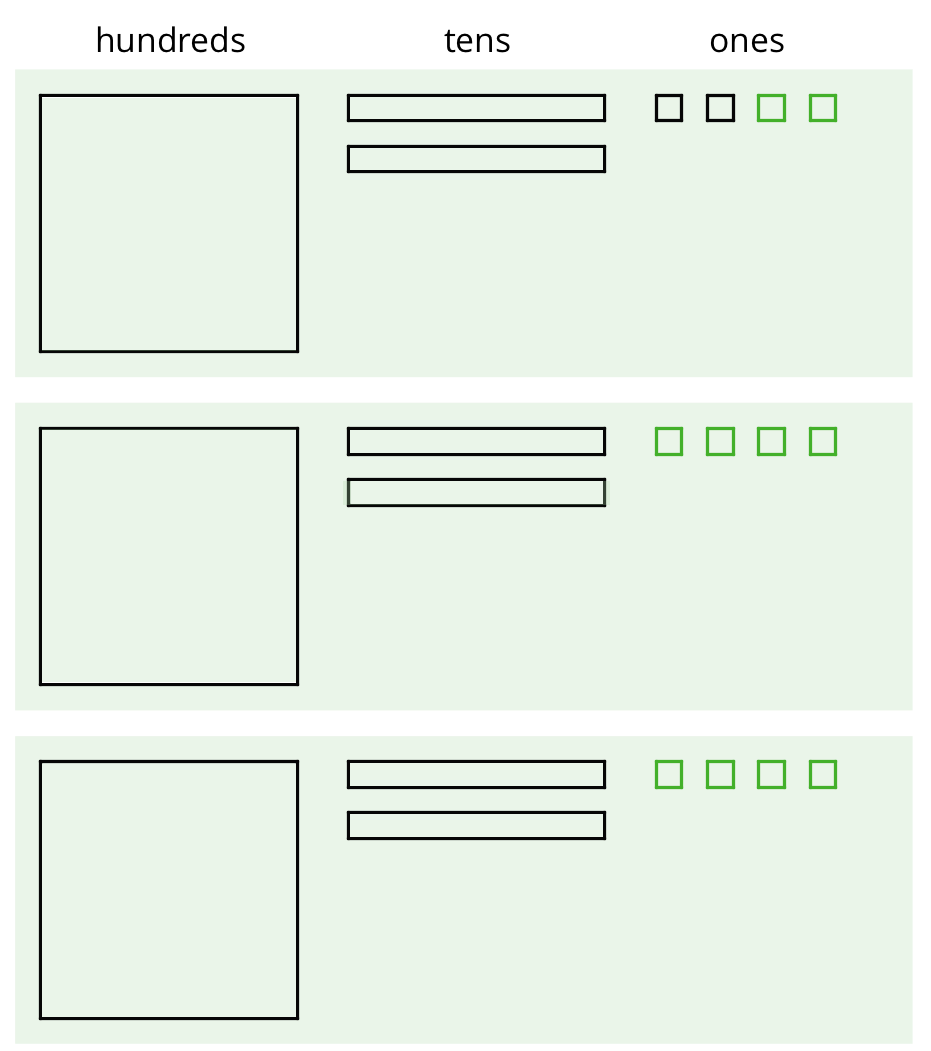
- Elena’s diagram for 372 has 7 tens. The one for \(372 \div 3\) has only 6 tens. Why?
- Where did the extra ones (small squares) come from?
Student Response
For access, consult one of our IM Certified Partners.
Anticipated Misconceptions
If students have difficulty making sense of Elena’s method, consider demonstrating her process with actual base-ten blocks or paper cutouts.
Activity Synthesis
Highlight Elena’s process of separating base-ten units into equal groups. Discuss:
- Which base-ten unit(s) did Elena unbundle or break up? (She unbundled a tens unit.)
- Why? What did unbundling accomplish? (She had only 1 ten left and there are 3 equal groups. Unbundling as smaller units made it possible to place the 1 ten in the 3 groups.)
- Is there another way that Elena could have made 3 equal groups out of the base-ten units? (She could have unbundled other larger units into smaller units—e.g., the 3 hundreds as 30 tens or all 7 tens as 70 ones—but it was not necessary.)
- How might one find \(378 \div 3\) using Elena’s method? (By thinking of 378 as 3 hundreds, 6 tens, and 18 ones and placing them into 3 equal groups.)
18.2: Using the Partial Quotients Method to Calculate Quotients (15 minutes)
Activity
Here, students continue to find quotients of whole numbers by thinking about equal-size groups and place value. They learn that, in addition to using base-ten diagrams, they can also form equal-size groups using only numbers and by thinking in terms of partial quotients. Just as they had used diagrams to place base-ten units—first hundreds, then tens, and then ones—into equal groups until all units are placed, they can distribute base-ten units of a number into equal groups until all of the units are placed.
Launch
Keep students in groups of 2. Display the following diagram for all to see, and explain that it shows Elena’s method of finding \(657 \div 3\). Give students a minute to analyze the diagram, determine what the quotient is, and be prepared to explain what the diagram shows.
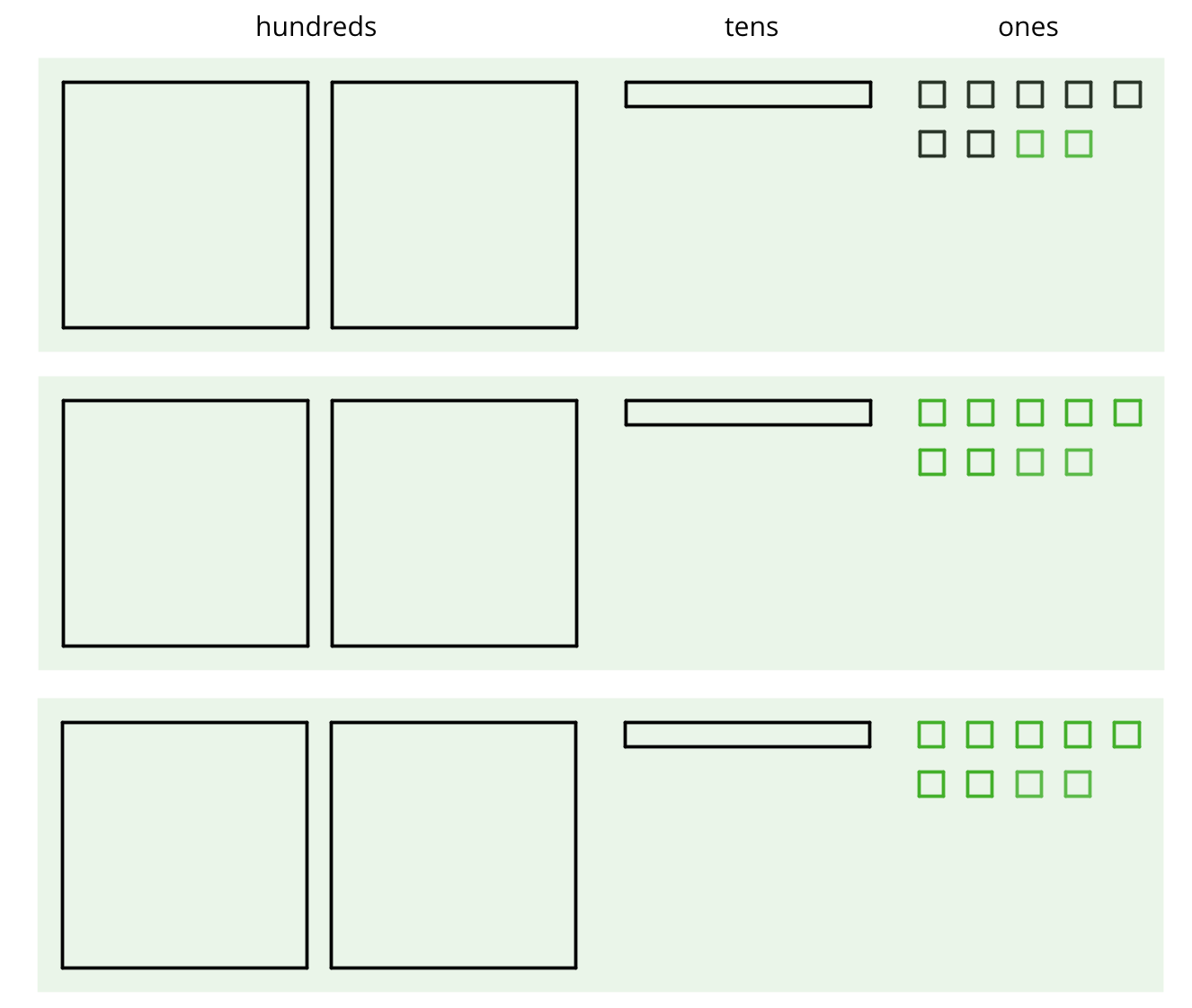
Give partners 1 minute to discuss their understanding of the diagram. Afterwards, consider asking a student to share with the class. Look for an explanation along the lines of the following:
- First, use the 6 hundreds to make 3 equal groups of 200.
- Then use 3 tens of the 5 tens to make 3 equal groups of 10.
- Unbundle the remaining 2 tens into 20 ones, combine them with the 7 ones, and split the 27 ones into 3 equal groups of 9.
If time permits, invite other students to elaborate on the presented explanations or share alternative analyses.
Keep Elena’s method from the previous task displayed for students to reference. Give students 7–8 minutes to think about and discuss Andre’s method in the first question and to complete the activity.
Provide access to graph paper. Tell students that they may find the grid helpful for aligning the digits when finding partial quotients.
Supports accessibility for: Visual-spatial processing
Design Principle(s): Cultivate conversation; Maximize meta-awareness
Student Facing
-
Andre calculated \(657 \div 3\) using a method that was different from Elena’s.
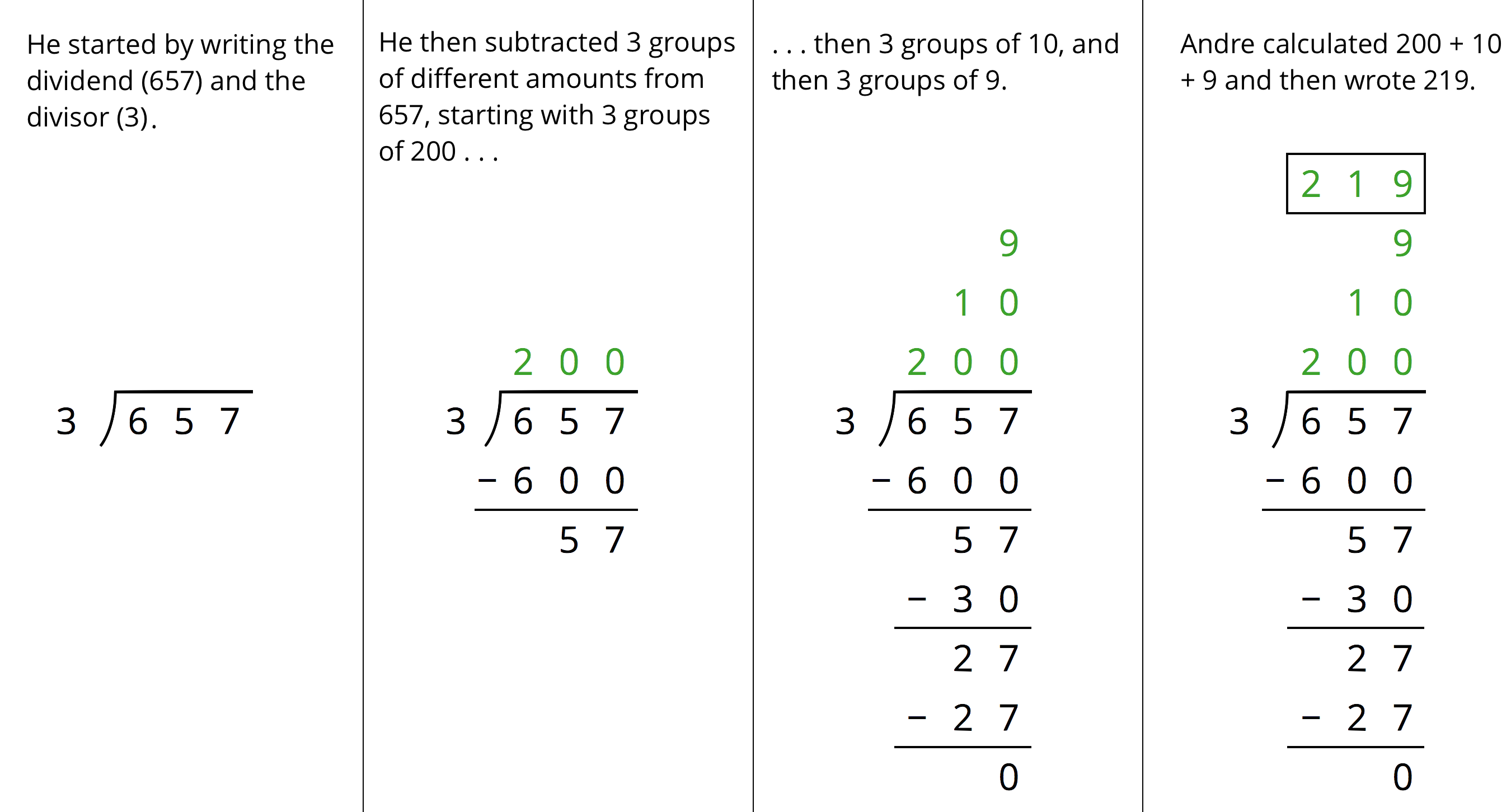
- Andre subtracted 600 from 657. What does the 600 represent?
- Andre wrote 10 above the 200, and then subtracted 30 from 57. How is the 30 related to the 10?
- What do the numbers 200, 10, and 9 represent?
- What is the meaning of the 0 at the bottom of Andre’s work?
-
How might Andre calculate \(896 \div 4\)? Explain or show your reasoning.
Student Response
For access, consult one of our IM Certified Partners.
Anticipated Misconceptions
When using the partial quotients method, students might make subtraction or multiplication errors because they did not line up the numbers appropriately. Prompt students to compare the structure of Andre’s work with their own or to check if they have aligned like units in their vertical calculations.
Activity Synthesis
Make sure students understand how the steps in Elena’s method and Andre’s method correspond. Discuss:
- Elena’s diagram shows 3 groups of 2 hundreds. Where in Andre’s method do we see the same value? (In the 600 subtracted from 657.)
- Where in Elena’s work do we see the 30 that Andre subtracts from 57? (In the 3 groups of 1 ten.)
- Do Andre and Elena both get the same answer? Why? (Yes, because they both distributed 657 into 3 equal groups.)
Tell students that Andre’s method is an example of the partial quotients method, in which we divide a part of the dividend at a time, obtaining part of the quotient each time. In this case, the first partial quotient is 200, next is 210 (from \(200+10\)), and last is the quotient 219 (from \(200+10+9\)). We can still view a division expression such as \(657 \div 3\) as a question asking “How many are in each group if I divide 657 into 3 equal groups?”
With the partial quotients method, we can take any amount we choose out of 657 and place it into the 3 equal groups. It is often helpful to take out the amount in each place value and distribute it into groups. The values placed in each group are partial quotients. Once we have distributed all of 657, we can add the partial quotients to find \(657 \div 3\).
If time allows, discuss how to find the value of \(655 \div 5\) using the partial quotients method. Ask students what value might be reasonable to take out first, second, etc. (e.g., taking out 100 or 120 is a reasonable first move).
18.3: Lin Uses Long Division (25 minutes)
Activity
This activity introduces the use of long division to calculate a quotient of whole numbers. Students make sense of the process of long division by studying an annotated example and relating it to the use of partial quotients and base-ten diagrams. They begin to see that long division is a variant of the partial quotients method, but it is calculated and recorded differently.
In the partial quotients method, the division is done in installments, resulting in a series of partial quotients. The size of each installment can vary, but it is always a multiple of the divisor. Each partial quotient is written above the dividend and stacked; the sum of all partial quotients is the quotient.
In long division, the division is performed digit by digit, from the largest place to the smallest, so the resulting quotient is also recorded one digit at a time. In each step, one more digit of the quotient is calculated. Students notice that although only one digit of the quotient is written down at a time, the value that it represents is communicated through its placement.
To become proficient in long division requires time, encounters with a variety of division problems, and considerable practice. Students will have opportunities to study the algorithm more closely and to use it to divide increasingly more challenging numbers over several upcoming lessons.
Launch
Tell students that they will now consider a third method—called long division—for solving the same division problem that Elena and Andre had calculated using base-ten diagrams and the partial quotients method. Encourage students to refer to their work on those activities, or display Elena and Andre’s methods for all to see. Ask a couple of students to briefly explain how Elena and Andre calculated \(657 \div 3\).
Arrange students in groups of 2. Give students 2–3 minutes of quiet think time to make sense of the annotated example of long division, and then 3–4 minutes to discuss the first set of questions with a partner. Follow with a whole-class discussion before students use long division to answer the second set of questions.
Display Lin’s method for all to see and ask a student to explain what Lin had done in his or her own words. Then, discuss students’ responses to the first set of questions and these questions:
-
In the first step, Lin divided 6 by 3 to get 2. Did it matter where Lin wrote the 2? Why did she put it over the 6? (Yes, it mattered. Because the 6 represents 600, she was really dividing 600 by 3, which is 200. The 2 needs to be written in the hundreds place to tell us its actual value.)
-
After writing down the 2, Lin subtracted 6. Why? And why was the result of the subtraction not 651 (since \(657-6=651\))? (Though she wrote a subtraction of 6, she actually subtracted 600. Because she had just divided 600 by 3, that portion of 657 is already accounted for.)
-
Could Lin have written the full amounts being subtracted instead of just the non-zero digit (e.g., subtracting by 600, 50 and 7, instead of subtracting by 6, 5, and 7 after aligning them to certain places)? (Yes, it would involve more writing, but it works just as well.)
-
How is this process similar to and different than the partial quotients method? (It is a similar idea of taking out a certain multiple of 3 at a time, but in long division we do it digit by digit and in the order of place value—from the largest unit to the smallest.)
Consider demonstrating the long-division process with another example such as \(912 \div 4\) before asking students to complete the rest of the task. Provide access to graph paper. Tell students that the grid could help them line up the digits.
Supports accessibility for: Language
Student Facing
Lin has a method of calculating quotients that is different from Elena’s method and Andre’s method. Here is how she found the quotient of \(657\div 3\):
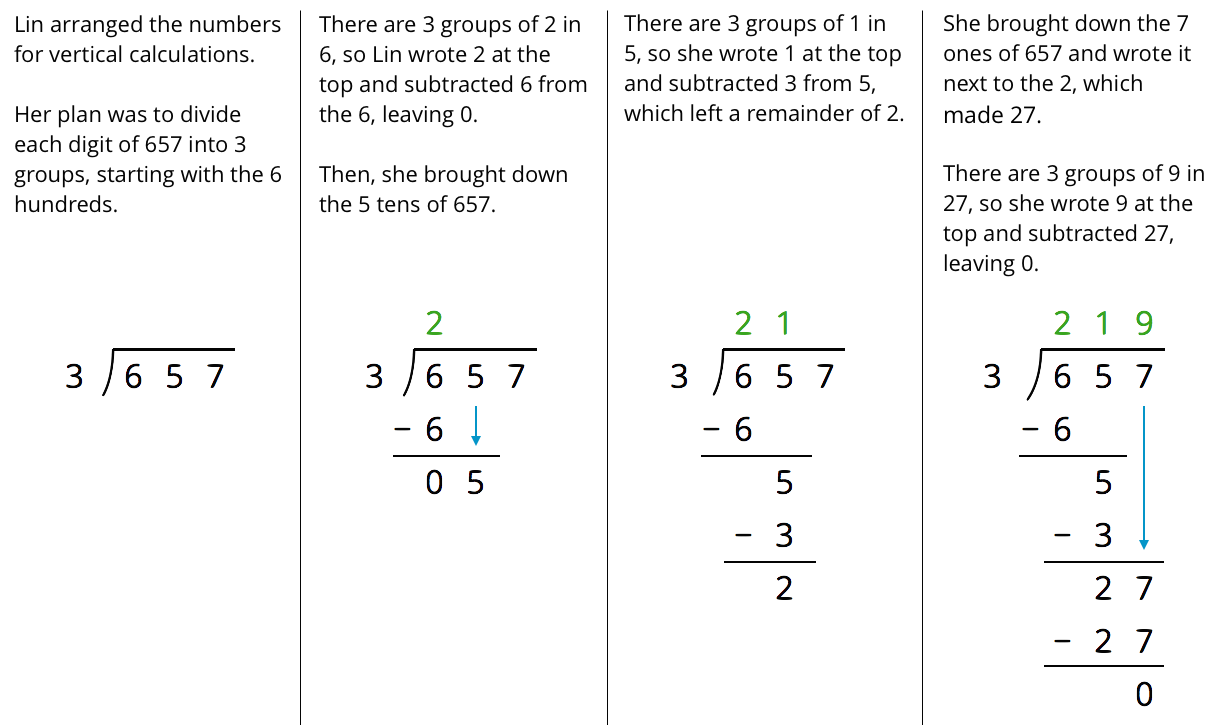
-
Discuss with your partner how Lin’s method is similar to and different from drawing base-ten diagrams or using the partial quotients method.
- Lin subtracted \( 3 \boldcdot 2,\) then \(3 \boldcdot 1\), and lastly \(3 \boldcdot 9\). Earlier, Andre subtracted \(3 \boldcdot 200,\) then \(3 \boldcdot 10\), and lastly \(3 \boldcdot 9\). Why did they have the same quotient?
- In the third step, why do you think Lin wrote the 7 next to the remainder of 2 rather than adding 7 and 2 to get 9?
-
Lin’s method is called long division. Use this method to find the following quotients. Check your answer by multiplying it by the divisor.
- \(846 \div 3\)
- \(1,\!816 \div 4\)
- \(768 \div 12\)
Student Response
For access, consult one of our IM Certified Partners.
Activity Synthesis
Display the worked-out long divisions for all to see. Select a student to explain the steps for at least one of the division problems. Highlight two ideas about long division: 1) we start by dividing the largest base-ten units and work toward smaller units, and 2) the placement of each digit of the quotient matters because it conveys the value of the digit.

Draw students’ attention to the second problem (\(1,\!816 \div 4\)) or third problem (\(768 \div 12\)), in which the first digit of the dividend is smaller than the divisor. Select 1–2 students to share how they approached these situations. If not brought up in students’ explanation, discuss how we could reason about these.
-
“Let’s take \(1,\!816 \div 4\) as an example. If we were using base-ten diagrams, we would have 1 piece representing a thousand. How would we divide that piece into 4 groups?” (We would unbundle it into 10 hundreds, add them to the 8 pieces representing 8 hundreds, and then distribute the 18 hundreds into 4 groups.)
-
“How can we apply the same idea to long division? If there is not enough thousands to divide into 4 groups, what can we do?” (We can think of the 1 thousand and 8 hundreds as 18 hundreds and divide that value instead.)
-
“How many hundreds would go into each group if we divide 18 hundreds into 4 groups?” (4 hundreds, with a remainder of 2 hundreds.)
-
“Where should we write the 4? Why?” (In the hundreds place, because it represents 4 hundreds.)
-
“How do we deal with the 2 hundreds?” (Since there is not enough to distribute into 4 groups, we can unbundle them into 20 tens, combine them with the 1 ten, and divide 21 tens by 4.)
Design Principle(s): Optimize output (for justification); Cultivate conversation
18.4: Dividing Whole Numbers (10 minutes)
Optional activity
In this activity, students continue to practice using long division to find quotients. Here, the presence of 0’s in the dividend and the quotient presents an added layer of complexity, prompting students to really make sense of the the meaning of each digit in numbers they are dealing with (MP7).
Launch
Give students 6–7 minutes of quiet work time. Follow with a whole-class discussion. Provide access to graph paper.
Supports accessibility for: Language; Social-emotional skills
Student Facing
-
Find each quotient.
- \(633 \div 3\)
- \(1001 \div 7\)
- \(2996\div14\)
-
Here is Priya’s calculation of \(906 \div 3\).
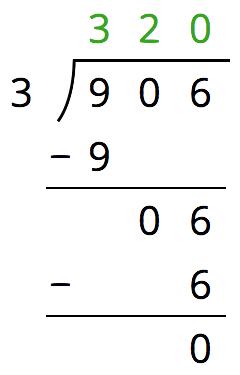
- Priya wrote 320 for the value of \(906 \div 3\). Check her answer by multiplying it by 3. What product do you get and what does it tell you about Priya’s answer?
- Describe Priya’s mistake, then show the correct calculation and answer.
Student Response
For access, consult one of our IM Certified Partners.
Activity Synthesis
Focus class discussion on attending to the meaning of each digit in performing division. Discuss:
-
How did you deal with the 0’s in 1,001? Would they cause any difficulty when doing long division? (I brought down the first 0 and then performed division like I would have done with any other digit. After subtracting one 7 from 10, I was left with 3. Putting a 0 after the 3 changes the value to 30. So even though the 0 alone has no value, it changes the value of the numbers in front of it).
-
How can you check your answer to a division problem such as \(1,\!001 \div 147\)? (We can check by multiplying the quotient by the divisor. If the division was done correctly, then \(143 \boldcdot 7 = 1,\!001\), which is true).
-
What happens if you check Priya’s answer for \(906 \div 3\)? (\(320 \boldcdot 3 = 960\), so this tells us that Priya’s answer is incorrect).
Make sure students notice that although checking an answer can tell you that you have made a mistake, it will not necessarily identify where the mistake is. It only works if you perform the multiplication correctly.
Design Principle(s): Cultivate conversation; Maximize meta-awareness
Lesson Synthesis
Lesson Synthesis
Long division is another method for finding quotients. It follows similar lines of reasoning for dividing with base-ten diagrams or using the partial quotients method. All three methods rely on the structure of the base-ten number system.
-
How is dividing using long division similar to dividing by drawing base-ten diagrams? (Even though one method involves drawing and the other involves using only numbers, they rely on the same principle of dividing base-ten units into equal-sized groups. In both methods, when there is not enough of a unit to divide equally into groups, we can unbundle the unit into the next smaller base-ten units.)
-
How is long division similar to and different from the partial quotients method? (They are similar in that we divide in “installments,” but in the partial quotients method, we can decide on the size of each installment or each group being subtracted from the dividend. In long division, we follow a very specific order based on place value and we divide digit by digit—from left to right, and subtract as large a group as possible at any step. In long division, we also do not write out all the numbers in our calculations; we use one digit at a time and rely on its place in the base-ten system to convey its value.)
-
Which method for finding quotients do you think is the most efficient? (It depends on the numbers involved. If the numbers are large or long, drawing would be laborious and prone to error, and using partial quotients might mean a whole lot of steps. Long division might be simpler because we are reasoning with one digit and one place-value unit at a time.)
18.5: Cool-down - Dividing by 15 (5 minutes)
Cool-Down
For access, consult one of our IM Certified Partners.
Student Lesson Summary
Student Facing
We can find the quotient \(345\div 3\) in different ways.
One way is to use a base-ten diagram to represent the hundreds, tens, and ones and to create equal-sized groups.

We can think of the division by 3 as splitting up 345 into 3 equal groups.
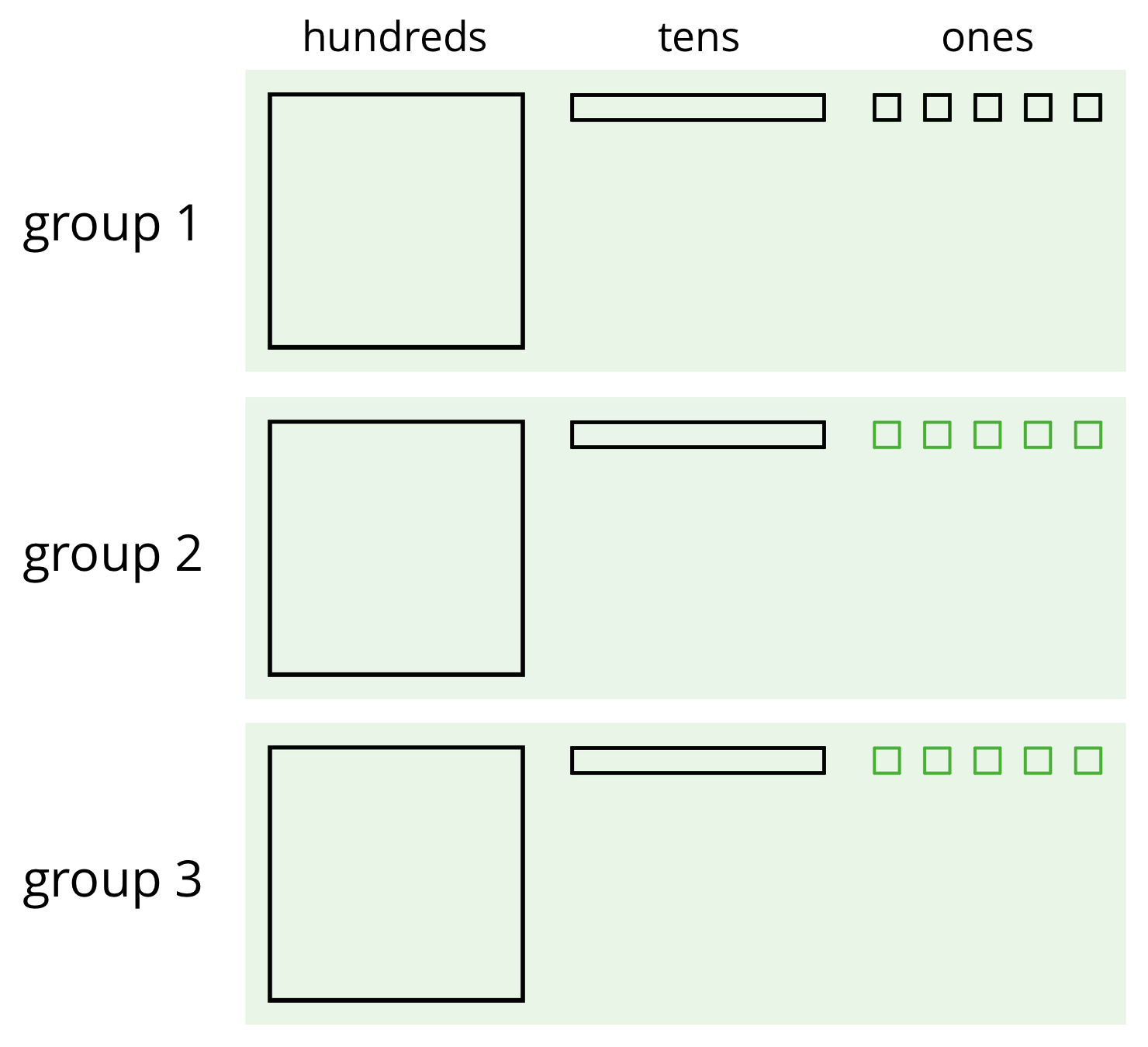
Each group has 1 hundred, 1 ten, and 5 ones, so \(345 \div 3 = 115\). Notice that in order to split 345 into 3 equal groups, one of the tens had to be unbundled or decomposed into 10 ones.
Long division is another method for calculating quotients. It relies on place value to perform and record the division.
When we use long division, we work from left to right and with one digit at a time, starting with the leftmost digit of the dividend. We remove the largest group possible each time, using the placement of the digit to indicate the size of each group. Here is an example of how to find \(345 \div 3\) using long division.
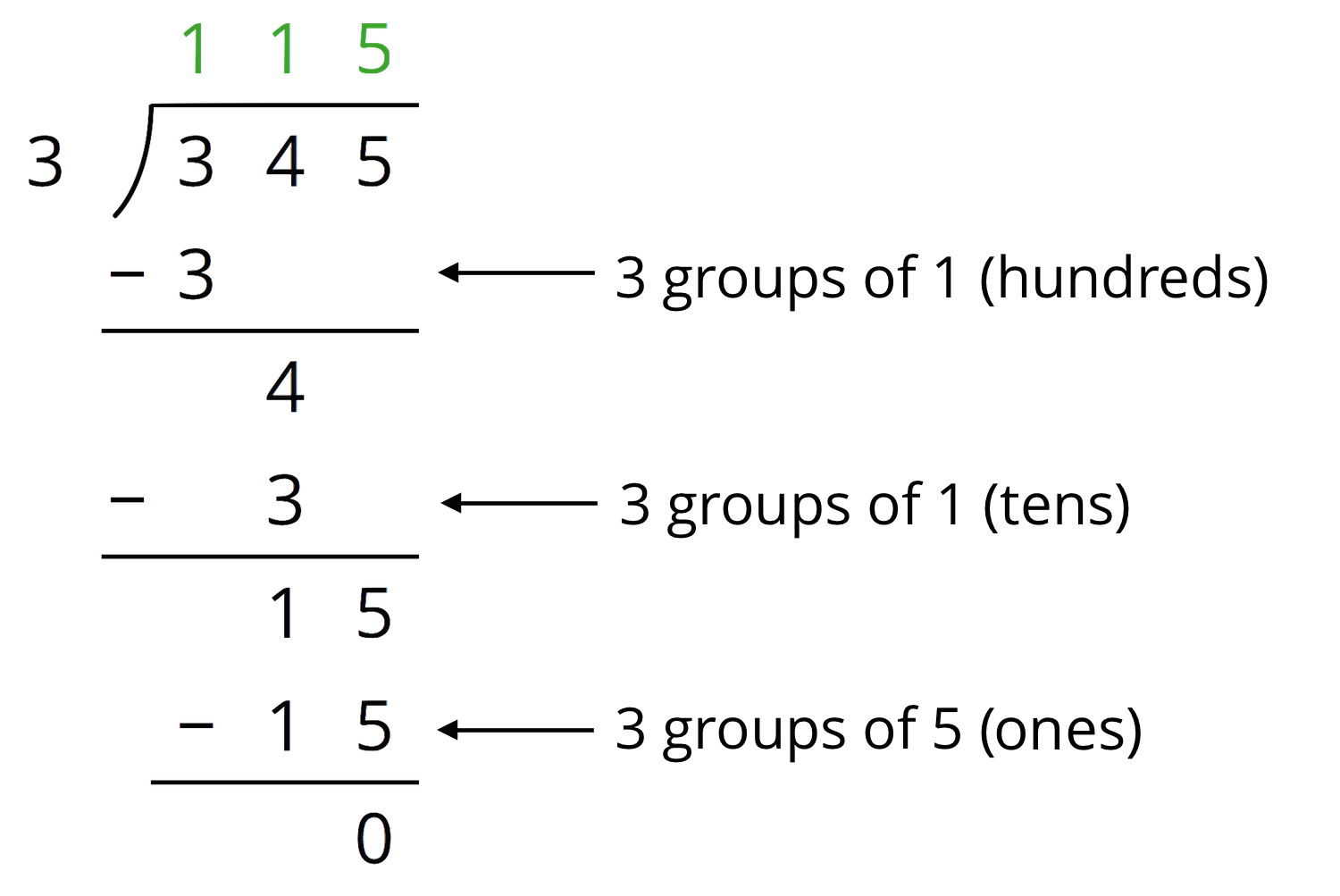
-
We start by dividing 3 hundreds into 3 groups, which means 1 hundred in each group. Instead of writing 100, we simply write 1 in the hundreds place, knowing that it means 1 hundred.
-
There are no remaining hundreds, so we work with the tens. We can make 3 groups of 1 ten in 4 tens, so we write 1 in the tens place above the 4 of 345. Subtracting 3 tens from 4 tens, we have a remainder of 1 ten.
-
We know that 1 ten is 10 ones. Combining these with the 5 ones from 345, we have 15 ones. We can make 3 groups of 5, so we write 5 in the ones place.
In total, there are 3 groups of 1 hundred, 1 ten, and 5 ones in 345, so \(345 \div 3 = 115\).